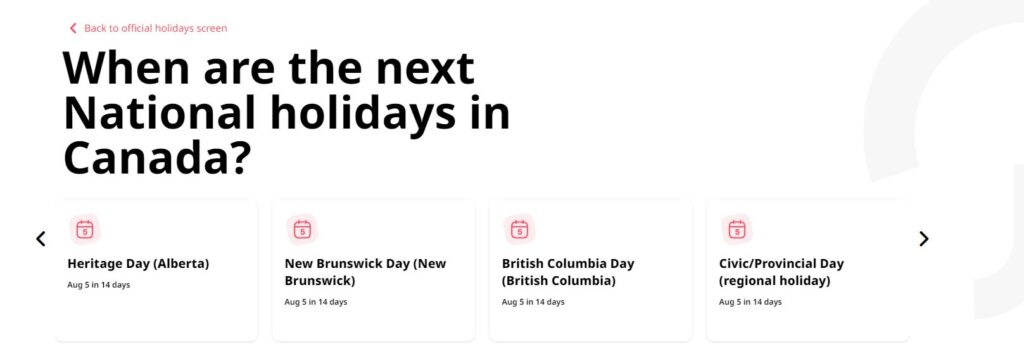Navigating Connecticut Leave Laws can be complex, with both federal and state regulations shaping Paid Time Off (PTO) and other types of leave, including day off policies. This guide simplifies the key aspects of Connecticut’s leave policies, covering vacation, sick leave, family and medical leave, and more. Whether you’re an employer or an employee, this overview will help you understand your rights and obligations regarding PTO, day off, and other leave entitlements in Connecticut.
Paid Time Off (PTO) in Connecticut
Vacation Leave Quota
Connecticut leave laws does not require employers to provide vacation leave, whether paid or unpaid. However, if an employer decides to offer vacation benefits, they must adhere to the terms specified in the employment contract or company policy. In unionized workplaces, vacation leave is a negotiable item and must be defined in a collective bargaining agreement.
Accrual
While Connecticut does not mandate vacation accrual, many companies implement it as part of their benefits package. For certain employers, sick leave accrual is required. Employers may also set a cap on the amount of vacation leave that employees can accumulate, ensuring that vacation hours do not exceed a certain limit.
Roll Over
Connecticut leave laws allows employers to implement a “Use It or Lose It” policy, which means that employees are not entitled to carry over unused vacation leave to the next year unless the employer’s policy explicitly permits it. The state does not have specific laws governing this policy, so it depends on the employer’s terms and conditions.
Statutory Provisions Addressing Vacation Pay
Under Connecticut leave laws, vacation time is not classified as “wages.” The right to vacation leave and the terms under which it is provided are governed by the employment contract or collective bargaining agreement. Therefore, if an employer offers vacation benefits, the specific provisions of the contract or agreement will dictate the amount and conditions of vacation time.
Payment of Accrued, Unused Vacation on Termination
Connecticut law does not require employers to pay employees for accrued, unused vacation time upon termination unless the employment contract or company policy stipulates such a payment. If the employer’s policy or contract includes provisions for paying out accrued vacation time, the employer is obligated to follow them. Failure to comply may result in penalties, including the possibility of paying twice the amount of unpaid wages and facing fines or imprisonment, depending on the amount owed.
Payout
In cases where the employer’s policy or contract requires it, accrued, unused vacation time must be paid out upon termination.
Sick Leave in Connecticut
Federal Laws – Leave Quota
Employers in Connecticut must comply with the Family and Medical Leave Act (FMLA), which allows eligible employees to take up to 12 weeks of unpaid, job protected leave each year for specific family and medical reasons. To qualify for FMLA, employees must have worked for the employer for at least one year, completed a minimum of 1,250 hours over the past year, and work at a location where the employer has 50 or more employees within 75 miles.
State Sick Leave Laws in Connecticut
Connecticut has a mandatory sick leave law that requires employers with 50 or more employees to provide paid sick leave to their service workers. These employees earn one hour of paid sick leave for every 40 hours worked, with a cap of 40 hours per year.
Eligible Employers and Employees
The Connecticut Paid Sick Leave Law applies to large employers with 50 or more employees in any quarter of the previous calendar year. The law specifically targets service workers, defined as those employed in certain occupational classifications, paid hourly, and not exempt from minimum wage and overtime requirements under the Fair Labor Standards Act (FLSA). To be eligible, employees must work an average of at least 10 hours per week.
Accrual Rate and Maximum
Employees accrue one hour of paid sick leave for every 40 hours worked, with a maximum accrual of 40 hours per year.
Rollover Rules
Employees may roll over up to 40 hours of unused sick leave to the next year, but they are only entitled to use up to 40 hours of sick leave in a single year.
Paid Sick Leave Use
Employees can use their sick leave for their own or their spouse’s or child’s illness, injury, or medical care. The law also covers time off for domestic violence or sexual assault, including medical and psychological care.
2023 Update
As of October 1, 2023, Connecticut expanded the permissible uses of paid sick leave to include “mental health wellness days” and leave for parents or guardians to care for children affected by family violence or sexual assault.
Waiting Period
Although employees begin accruing sick leave immediately upon employment, they can only use it after working 680 hours. For employees working eight-hour days, this equates to 85 days of employment.
Protection
Employers are prohibited from retaliating against employees who request or use eligible paid sick leave.
Payout
Employers are required to pay for eligible sick leave.
Connecticut Family and Medical Leave (CTFMLA)
Connecticut Family and Medical Leave (CTFMLA)
In addition to FMLA, Connecticut has its own family and medical leave law (CTFMLA), which requires employers with 75 or more employees to provide up to 16 weeks of unpaid, job protected leave every 24 months. Employees are eligible for this leave if they have worked for the employer for at least one year and have completed a minimum of 1,000 hours during that period.
Paid Family and Medical Leave Act (PFMLA)
Connecticut’s Paid Family and Medical Leave Act (PFMLA) became effective on January 1, 2022. This program is funded by employee payroll deductions, which began on January 1, 2021. Employees who meet the eligibility criteria may receive up to 12 weeks of paid leave in a year, with an additional two weeks available for pregnancy related health conditions. Benefits can be as high as 95% of the employee’s regular weekly pay, capped at 60 times the state minimum wage.
Eligibility for PFMLA
To qualify for PFMLA benefits, employees must have earned $2,325 in the highest earning quarter of the previous four quarters and must be currently employed or have been employed within the last 12 weeks.
Covered Reasons
PFMLA covers various reasons, including the birth or adoption of a child, caring for a family member with a serious health condition, the employee’s serious health condition, organ or bone marrow donation, and certain situations related to military service.
Payout
PFMLA is funded through mandatory payroll deductions from employees’ wages.
Maternity, Paternity, and FMLA in Connecticut
Federal Law
The FMLA provides 12 weeks of unpaid maternity/paternity leave for eligible employees working for employers with 50 or more workers. This leave is job-protected and applies to both the birth of a child and adoption.
Connecticut Family and Medical Leave (CTFMLA)
The CTFMLA allows eligible employees to take up to 16 weeks of unpaid leave over a 24 month period for the birth or adoption of a child or the placement of a foster child. The CTFMLA applies only to employers with 75 or more employees, and employees must have worked 1,000 hours in the preceding 12 months to be eligible.
Paid Family and Medical Leave Act (PFMLA)
Under Connecticut’s PFMLA, eligible employees can take up to 12 weeks of paid leave in a 12 month period, with an additional two weeks available for pregnancy related health conditions. This leave is funded through employee payroll deductions.
Pregnancy Discrimination and Accommodation in the Workplace
Connecticut leave laws requires employers with three or more employees to provide unpaid pregnancy leave for disabilities related to pregnancy or childbirth, typically lasting 6 to 8 weeks. The law also protects against discrimination related to pregnancy, childbirth, or related conditions such as breastfeeding and mandates reasonable accommodations, job protection, and reinstatement.
Bereavement Leave in Connecticut
Connecticut law does not require employers to provide paid or unpaid bereavement leave. However, employers who choose to offer such leave must adhere to their established policy or practice.
Jury Duty Leave in Connecticut
Connecticut law requires employers to provide employees with five days of paid leave for jury duty. After the fifth day, the state pays a stipend of $50 per day. Employers must not fire or otherwise penalize employees for serving on a jury.
Military Leave in Connecticut
Employers in Connecticut must allow employees to take unpaid leave for military duty, including meetings or drills. Additionally, employers subject to the Connecticut Family and Medical Leave Act must allow up to 26 workweeks of leave in any 12 month period to care for a family member injured in the line of duty. This leave is unpaid.
Voting Leave in Connecticut
Connecticut law mandates that employers provide two hours of unpaid leave for voting on election day. Employees must request this time off at least two working days in advance. This law is in effect until June 30, 2024.
Connecticut State Holidays for 2026
Private employers in Connecticut are not required by law to provide holiday leave. If an employer does offer paid or unpaid holiday leave, they must follow their established company policy or employment contract. Connecticut officially observes 13 state holidays.
This comprehensive overview of Connecticut’s leave policies highlights the various types of leave employees may be entitled to, along with the corresponding legal requirements for employers.
FAQ
Is paid vacation leave mandatory in Connecticut?
No. Connecticut law does not require employers to provide paid vacation leave. However, if an employer chooses to offer it, they must follow their written policy or employment agreement regarding accrual, usage, and payout upon termination.
Are employers required to pay out unused vacation time when an employee leaves?
Yes, if the employer’s policy or contract states that unused vacation time will be paid out upon termination, they are legally obligated to do so. If there is no such policy, payout is not required.
Does Connecticut have a paid sick leave law?
Yes. Under the Connecticut Paid Sick Leave law, most employers with 50 or more employees must provide up to 40 hours of paid sick leave per year to eligible service workers. Employees accrue one hour of paid sick leave for every 40 hours worked.
What is the Connecticut Paid Leave (CTPL) program?
The Connecticut Paid Leave program provides paid time off for eligible workers who need leave for medical, family, or caregiving reasons. It offers up to 12 weeks of paid leave (plus two additional weeks for pregnancy related complications) funded by employee payroll contributions.
When can employees start using paid family or medical leave?
Employees can apply for Connecticut Paid Leave benefits once they meet the program’s eligibility requirements, including having earned wages in the state and contributed to the Paid Leave Trust Fund.
Is maternity or paternity leave paid in Connecticut?
Yes. Eligible employees can receive paid benefits through the CT Paid Leave program for childbirth, adoption, or bonding with a new child. Additional unpaid, job protected leave may be available under the federal FMLA or Connecticut Family and Medical Leave Act (CTFMLA).
Does Connecticut require employers to provide bereavement leave?
No. There is no state law mandating bereavement leave. Employers may choose to provide it according to their internal policies or employee handbooks.
Are employees entitled to jury duty leave in Connecticut?
Yes. Employers must provide job protected leave for jury duty. Full time employees are entitled to their regular pay for the first five days of jury service. Employers cannot penalize employees for fulfilling jury obligations.
Are employees entitled to time off to vote in Connecticut?
Yes. Connecticut law requires employers to grant employees up to two hours of unpaid time off to vote in state elections, provided the employee requests it at least two working days in advance.
What public holidays are observed in Connecticut?
Connecticut observes the following state and federal holidays:
New Year’s Day
Martin Luther King Jr. Day
Lincoln’s Birthday
Washington’s Birthday (Presidents’ Day)
Good Friday
Memorial Day
Independence Day
Labor Day
Columbus Day
Veterans Day
Thanksgiving Day
Christmas Day
Are private employers required to provide paid holiday leave?
No. Private employers in Connecticut are not required by law to provide paid or unpaid time off for holidays. However, many choose to do so as part of their company policy or benefits package.
How can the Day Off app help Connecticut businesses manage leave?
The Day Off app simplifies leave tracking and compliance by helping Connecticut employers manage PTO, sick leave, and holidays in one platform. It supports custom leave policies, integrates with tools like Google Calendar, and ensures accurate accrual and reporting.












